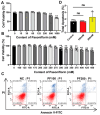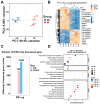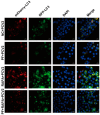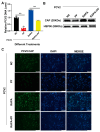Paeoniflorin Inhibits Porcine Circovirus Type 2 Replication by Inhibiting Autophagy and Targeting AKT/mTOR Signaling
- PMID: 40005877
- PMCID: PMC11860941
- DOI: 10.3390/vetsci12020117
Paeoniflorin Inhibits Porcine Circovirus Type 2 Replication by Inhibiting Autophagy and Targeting AKT/mTOR Signaling
Abstract
Porcine circovirus type 2 (PCV2) is an important pathogen that leads to great economic losses to the swine industry. Paeoniflorin (PF), a novel plant extract, has been reported to have antiviral properties. However, the role of paeoniflorin in regulating PCV2 replication remains unclear. Here, we used the CCK8 assay to demonstrate that PF within safe concentrations (0-275 mM) significantly inhibits PCV2 replication in a dose-dependent manner in porcine kidney cells. Subsequently, comparative transcriptome and functional verification revealed that PF probably inherits PCV2 replication via targeting AKT/mTOR signaling. Further experimental data show that the AKT/mTOR signaling pathway is highly relevant to autophagy. Thus, experimental data from Western blot, qPCR, and the indirect immunofluorescence test indicate that PF inhibits PCV2 replication by inhibiting autophagy by targeting the AKT/mTOR signaling pathway. Together, our results provide insight into the mechanism of paeoniflorin in regulating PCV2 replication and offer new ideas for the treatment of PCV2 infection in pigs.
Keywords: AKT/mTOR signaling; autophagy; paeoniflorin; porcine circovirus type 2.
Conflict of interest statement
The authors declare that they have no known competing financial interests or personal relationships that could have appeared to influence the work reported in this paper.
Figures










Similar articles
-
SeMet attenuates OTA-induced PCV2 replication promotion by inhibiting autophagy by activating the AKT/mTOR signaling pathway.Vet Res. 2018 Feb 13;49(1):15. doi: 10.1186/s13567-018-0508-z. Vet Res. 2018. PMID: 29439710 Free PMC article.
-
miR-214-5p/C1QTNF1 axis enhances PCV2 replication through promoting autophagy by targeting AKT/mTOR signaling pathway.Virus Res. 2023 Jan 2;323:198990. doi: 10.1016/j.virusres.2022.198990. Epub 2022 Oct 24. Virus Res. 2023. PMID: 36302471 Free PMC article.
-
Porcine MKRN1 Modulates the Replication and Pathogenesis of Porcine Circovirus Type 2 by Inducing Capsid Protein Ubiquitination and Degradation.J Virol. 2018 May 14;92(11):e00100-18. doi: 10.1128/JVI.00100-18. Print 2018 Jun 1. J Virol. 2018. PMID: 29514908 Free PMC article.
-
MicroRNA-30a-5p promotes replication of porcine circovirus type 2 through enhancing autophagy by targeting 14-3-3.Arch Virol. 2017 Sep;162(9):2643-2654. doi: 10.1007/s00705-017-3400-7. Epub 2017 May 22. Arch Virol. 2017. PMID: 28530014
-
Interactions of porcine circovirus 2 with its hosts.Virus Genes. 2016 Aug;52(4):437-44. doi: 10.1007/s11262-016-1326-x. Epub 2016 Mar 25. Virus Genes. 2016. PMID: 27016220 Review.
Cited by
-
Influence of paeoniflorin dietary supplementation on growth performance, antioxidant status, blood parameters, carcass characteristics and meat quality in broiler chickens.Vet Anim Sci. 2025 Apr 3;28:100450. doi: 10.1016/j.vas.2025.100450. eCollection 2025 Jun. Vet Anim Sci. 2025. PMID: 40256759 Free PMC article.
References
Grants and funding
LinkOut - more resources
Full Text Sources
Miscellaneous

